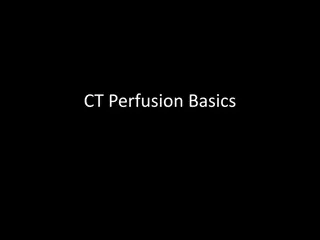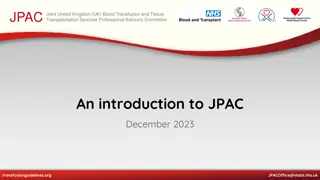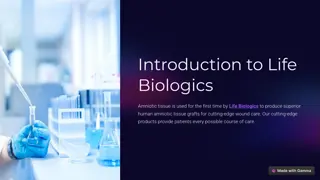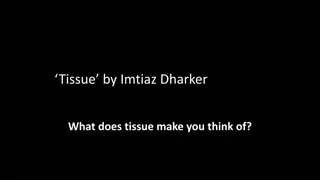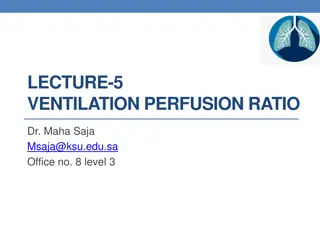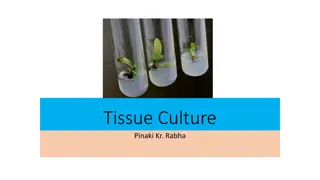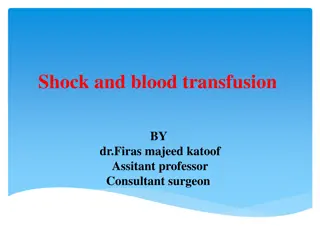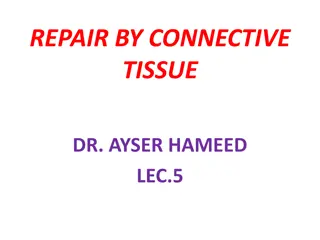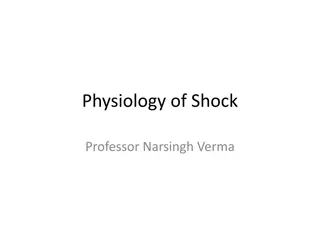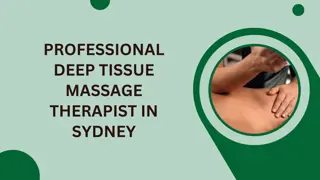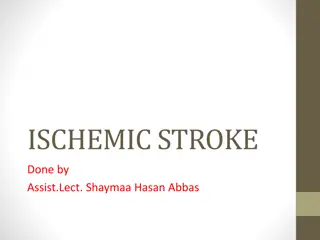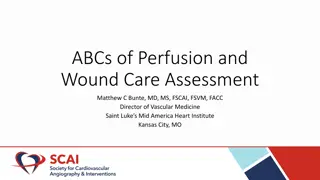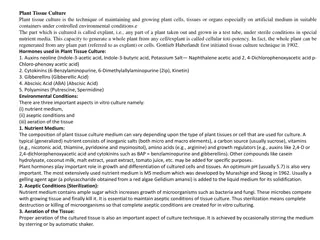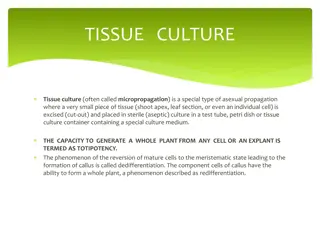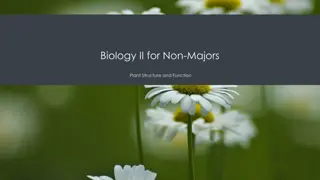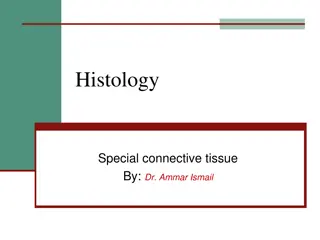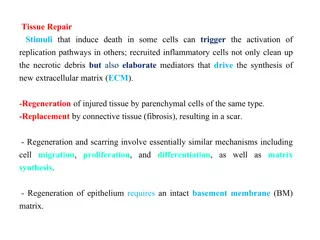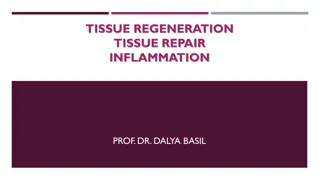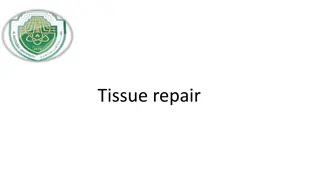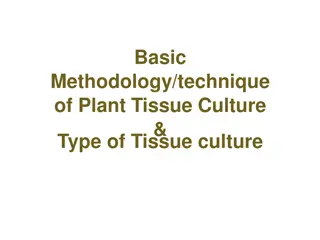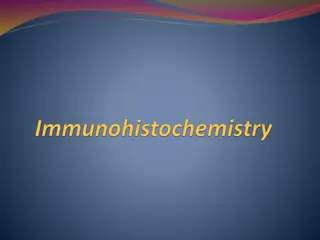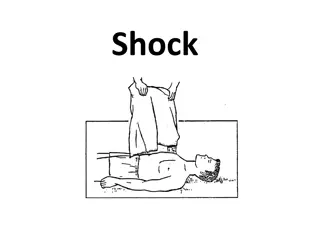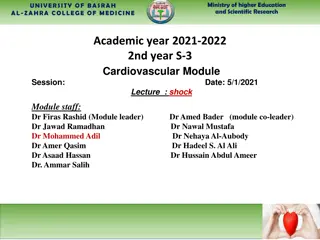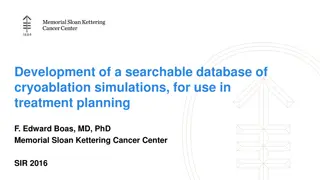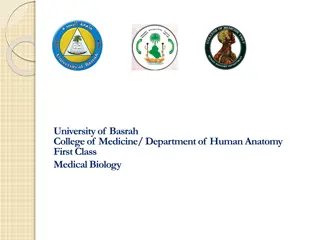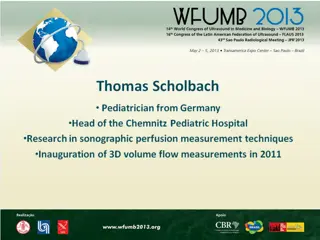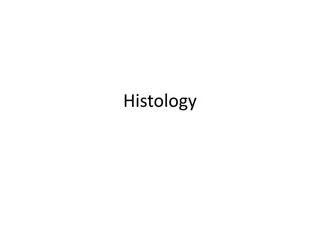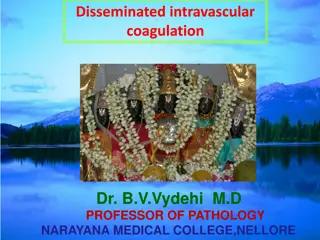Automated CT Perfusion Imaging in Acute Ischemic Stroke: Overview
This presentation delves into the significance of automated CT perfusion imaging in diagnosing and treating acute ischemic stroke. It covers essential information such as the burden of stroke in Ontario, the critical aspect of time in stroke treatment, hyperacute stroke treatment goals, and the impo
6 views • 41 slides
Basic CT Perfusion Terms in Stroke Imaging
This educational content delves into fundamental concepts related to CT perfusion imaging in stroke evaluation. It covers key terms such as core infarct, penumbra, Time to Peak, Mean Transit Time, Cerebral Blood Volume, and more. The information includes definitions, descriptions, and the significan
6 views • 16 slides
Overview of JPAC: United Kingdom Blood Transfusion and Tissue Transplantation Services
JPAC, the Joint United Kingdom (UK) Blood Transfusion and Tissue Transplantation Services Professional Advisory Committee, plays a crucial role in providing guidelines and ensuring standardization and safety in the field of blood transfusion. Established in the late 1980s, JPAC has evolved to become
1 views • 33 slides
Advancing Healthcare: Potential of Advanced Amniotic Tissue by Life Biologics
Life Biologics is at the forefront of using amniotic tissue to develop premium human amniotic tissue grafts for advanced wound care. Our innovative products offer patients a comprehensive range of treatment options. Life Biologics' advanced skin substitutes provide a revolutionary solution for both
0 views • 5 slides
Symbolism and Connections in "Tissue" by Imtiaz Dharker
This analysis delves into the symbolism present in Imtiaz Dharker's poem "Tissue," drawing connections between paper, human skin, and architecture. The poem reflects on the fragility of human power through the metaphor of tissue and explores the intricate layers that make up an individual's identity
0 views • 23 slides
Regulation of Extracellular Fluid Volume in Renal Physiology
This lecture focuses on the mechanisms involved in the regulation of extracellular fluid volume, primarily highlighting the role of sensors, effectors, and the kidney in maintaining body fluid balance. It discusses the importance of regulating extracellular fluid volume and osmolarity for controllin
0 views • 25 slides
Ventilation-Perfusion Ratio in Pulmonary Circulation
This lecture delves into the intricate relationship between ventilation and perfusion in the lungs, highlighting the importance of proper gas exchange for optimal respiratory function. It discusses the circulations supplying the lungs, defines the V/Q ratio, and explores the clinical significance of
0 views • 25 slides
Plant Tissue Culture: Methods and Requirements
Plant tissue culture involves the in-vitro culture of plant explants under aseptic conditions, covering cell, organ, and suspension cultures. This process, pioneered by German botanist Gottlieb Haberlandt, relies on the totipotency of plant cells. Key requirements include laboratory organization, su
1 views • 18 slides
Shock and Blood Transfusion in Surgery
Shock is a state of low tissue perfusion leading to metabolic changes like anaerobic metabolism and acidosis. As cellular hypoxia progresses, immune and coagulation responses are activated, impacting cardiovascular, respiratory, renal, and endocrine systems. Shock can be classified into hypovolaemic
1 views • 38 slides
Repair by Connective Tissue in Healing Processes
Healing or repair by connective tissue occurs in response to severe or chronic tissue injuries, leading to the replacement of nonregenerated cells with connective tissue or scar formation. This process involves the induction of fibroblast and endothelial cell proliferation, granulation tissue format
3 views • 26 slides
The Physiology of Shock by Professor Narsingh Verma
Shock is a critical condition resulting from poor tissue perfusion and impaired cellular metabolism. Various definitions describe it as inadequate delivery of oxygen and nutrients, leading to reversible or irreversible cellular injury. Different types of shock, such as hypovolemic shock, have common
0 views • 24 slides
Professional Deep Tissue Massage Therapist in Sydney
We have highly experienced and qualified Deep Tissue Massage Therapist in Sydney who provide comprehensive and customised deep tissue massage that will leave you 100% satisfied.
18 views • 6 slides
Best Deep Tissue Massage in Mosman
Are you looking for the Best Deep Tissue Massage in Mosman? Then contact Similan Thai Massage Cremorne. They offer a range of massage treatments, including traditional Thai massage, foot reflexology, aromatherapy, deep tissue massage, sport massage,
0 views • 6 slides
H&E Staining in Histology
H&E staining, a widely used histological technique, involves staining cell nuclei blue and cytoplasmic components pink to aid in tissue structure analysis. This method provides essential insights into normal and pathological tissue changes, assisting in diagnoses and further testing decisions. The p
0 views • 7 slides
Comprehensive Treatment Guidelines for Acute Ischemic Stroke
In the management of acute ischemic stroke, the primary goals are to reduce secondary brain damage, maintain adequate perfusion, and prevent recurrent strokes by managing risk factors. Treatment includes maintaining tissue oxygenation, correcting volume status and electrolytes, managing blood glucos
0 views • 20 slides
Perfusion and Wound Care Assessment
This comprehensive presentation delves into the critical aspects of perfusion and wound care assessment, covering topics such as tissue oxygenation, measuring tissue perfusion, diagnostic testing for critical limb ischemia, and techniques like ankle and toe systolic pressure measurement and transcut
0 views • 19 slides
Plant Tissue Culture: Techniques and Applications
Plant tissue culture involves maintaining and growing plant cells, tissues, or organs in artificial mediums under controlled conditions. It allows the regeneration of whole plants from small plant parts or cells. Hormones like auxins, cytokinins, and gibberellins are used in the process. Proper envi
3 views • 5 slides
Tissue Culture and Explant Selection in Plant Micropropagation
Tissue culture, or micropropagation, involves propagating plants from small tissue pieces in sterile culture. The process of dedifferentiation and redifferentiation allows for the regeneration of whole plants from individual cells or explants. Explants, selected from meristematic tissue, develop cal
1 views • 47 slides
Plant Structure and Function in Biology II for Non-Majors
Explore the intricate world of plant cells and tissues in Biology II for Non-Majors. Learn about the different types of plant cells - parenchymal, collenchymal, and sclerenchymal - each with unique structures and functions. Delve into the diverse plant tissue systems, from meristematic tissue for gr
0 views • 78 slides
Epithelial Tissue in General Histology
Epithelial tissue is a crucial type of tissue in the human body, performing functions like protection, absorption, secretion, and sensation detection. This tissue is composed of cells with minimal extracellular matrix and plays a vital role in various bodily processes. Learn about the classification
0 views • 47 slides
Overview of Special Connective Tissue: Cartilage - Histology by Dr. Ammar Ismail
Cartilage is a specialized connective tissue with chondrocytes in lacunae, lacking vasculature and nerves. Hyaline cartilage is common in the body, while elastic cartilage contains elastic fibers, and fibrocartilage is associated with dense connective tissue. Cartilage growth occurs through chondroc
0 views • 20 slides
Tissue Repair Mechanisms: Regeneration and Fibrosis
Tissue repair involves complex mechanisms like regeneration by parenchymal cells or fibrosis leading to scar formation. Inflammatory cells play a crucial role in tissue repair, along with processes like ECM synthesis and cell migration. Different types of cells in the body have varying regenerative
0 views • 20 slides
Tissue Regeneration, Repair, and Inflammation Explained
Tissue regeneration and repair processes involve either regeneration of cells or connective tissue repair, depending on the type of cells injured. In cases where regeneration is not possible, healing occurs through the formation of scar tissue. The healing process aims to restore the structural cont
0 views • 40 slides
Tissue Repair: Regeneration and Fibrosis Mechanisms
Tissue repair involves two primary mechanisms: regeneration, where some tissues can replace damaged cells, and fibrosis, where scar tissue forms if regeneration is not possible. Cell proliferation, growth factors, and cell population control play key roles in the restoration of tissue architecture a
0 views • 15 slides
The Human Tissue Act 2004 and DNA Analysis
The Human Tissue Act 2004 regulates the removal, storage, and use of tissue and organs from both living and deceased individuals in England, Wales, and Northern Ireland. The Human Tissue Authority (HTA) oversees the implementation of this act, ensuring safe and ethical use of human tissue. Consent i
0 views • 20 slides
Animal Tissues: Epithelial, Muscle, Nerve, and Connective Tissues
Explore the four general categories of animal tissue - epithelial, muscle, nerve, and connective tissues. Learn about the traits, classification, examples, and functions of each type of tissue. From the tightly packed cells of epithelial tissue to the excitable nature of muscle tissue, delve into th
2 views • 22 slides
Plant Tissue Culture Techniques and Types Explained
Plant tissue culture involves the isolation and growth of plant cells in a controlled environment. The process includes preparation of nutrient medium, selection and sterilization of explants, inoculation on a solid medium, incubation, regeneration of plantlets, and transfer for hardening and growth
0 views • 38 slides
Overview of Immunohistochemistry (IHC) in Diagnostic and Research Laboratories
Immunohistochemistry (IHC) is a technique used to detect antigens in tissue sections by utilizing antibodies that bind specifically to target antigens. This method has evolved since the 1930s and plays a vital role in disease diagnosis, drug development, and biological research. IHC combines anatomi
0 views • 19 slides
Surgical Suture Materials and Techniques
Surgical sutures play a crucial role in wound repair by providing support and hemostasis to healing tissue. An ideal suture should meet specific criteria for handling, reaction in tissue, bacterial growth inhibition, knot security, and more. Factors like suture size, flexibility, and surface charact
0 views • 24 slides
Shock: Definitions, Types, and Management Principles
Shock is a condition characterized by inadequate tissue perfusion, leading to a range of systemic effects. This article outlines the definitions, signs and symptoms, general principles of management, and specific types of shock, including hypovolemic, cardiogenic, neurogenic, anaphylactic, and septi
0 views • 20 slides
Shock: Types, Mechanisms, and Pathophysiology
Shock, a state of systemic hypotension resulting in impaired tissue perfusion and cellular hypoxia, has various types such as cardiogenic, hypovolemic, septic, neurogenic, and anaphylactic shock. Each type has different mechanisms and causes, leading to decreased cardiac output and multiorgan failur
0 views • 45 slides
Shock in Medical Science: Definitions, Classification, and Management
Shock is a critical condition caused by poor tissue perfusion leading to impaired cellular metabolism. This article discusses the definition of shock, its classification including septic, anaphylactic, cardiogenic, hypovolemic, and neurogenic shock, along with the clinical manifestations and hemodyn
0 views • 19 slides
Cryoablation Simulation Database Development for Treatment Planning
Development of a searchable database of cryoablation simulations for treatment planning purposes. Includes details on cryoablation instructions, simulations using the Pennes bioheat equation, heat diffusion, tissue perfusion, and accuracy in predicting ice ball size in gel. Financial disclosures of
0 views • 20 slides
Cardiorenal Syndrome: A Complex Relationship Between the Heart and Kidneys
Cardiorenal Syndrome is a condition where dysfunction in one organ, whether acute or chronic, can lead to dysfunction in the other. This complex relationship involves intricate communication pathways between the heart and kidneys, impacting hemodynamic stability, organ perfusion, and neurohormonal i
0 views • 15 slides
Epithelial Tissue in Human Anatomy: A Comprehensive Overview
Epithelial tissue is a vital component of the human body, serving as a protective barrier and interface with the external environment. This tissue type, along with other essential tissues, plays a crucial role in the development and function of organs. Learn about the structure, function, and signif
0 views • 22 slides
Microvascular Perfusion Loss in Kidneys of Children with Type 1 Diabetes
Dynamic tissue perfusion measurement using PixelFlux reveals microvascular perfusion loss in the kidneys of children with type 1 diabetes. This study examines the impact of diabetes duration, A1C levels, dyslipidemia, and blood pressure on renal microvessel disease. PixelFlux, a color Doppler ultras
0 views • 23 slides
Basic Histology and Tissue Types
Explore histology, tissues, and types of tissues including epithelial, connective, muscle, and nerve tissues. Learn about tissue characteristics, differences, and functions, as well as details on specific tissue types like cardiac muscle, bone tissue, skeletal muscle, and smooth muscle. Delve into e
0 views • 74 slides
Regulation of Human Tissue and DNA Analysis under HTA 2004
The Human Tissue Act 2004 regulates the removal, storage, and use of tissues from deceased and living individuals. The Human Tissue Authority oversees the implementation of this act and provides guidance on safe and ethical use of human tissue. The act covers bodily and relevant material and emphasi
0 views • 20 slides
The Four Basic Types of Tissue
Explore the four basic types of tissue in the human body: connective tissue, epithelial tissue, muscle tissue, and nervous tissue. Learn about their functions and characteristics to gain a deeper understanding of the body's structure and functions after a lecture session.
0 views • 7 slides
Disseminated Intravascular Coagulation
Dhrombohemorrhagic disorder secondary to various diseases, characterized by coagulation activation and microthrombi formation. Major disorders associated with DIC include obstetric complications, neoplasms, and tissue injuries. Pathophysiology involves tissue thromboplastin sources, endothelial inju
0 views • 17 slides

